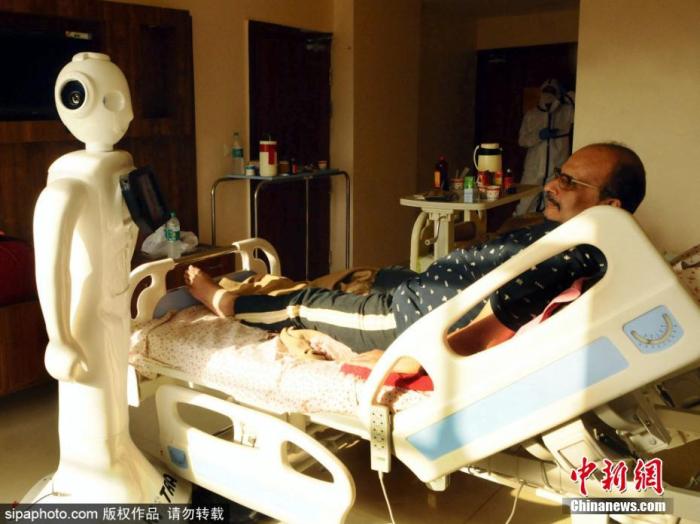China News Service, October 3, reported that the new crown epidemic in India is spreading rapidly. The government announced on the 3rd local time that more than 100,000 people in India have died from the new crown virus.
So far, India has become the country with the third largest number of new crown deaths in the world, second only to the United States and Brazil.
However, some experts pointed out that the actual number of deaths from the new crown in India may be more.
On September 28, local time, Noida, India, Yathartha Hospital in Uttar Pradesh, India, used robots to help patients contact the outside world.
Image source: Sipaphoto copyright works please do not reprint
"I may die of the new crown virus, but I don't care"
Ramanand Saka never thought of living by cremating the remains, but he was heavily indebted and urgently needed funds.
The 43-year-old man escaped from a remote village in Assam in northeastern India because he could not repay his loan.
But even in big cities, it is difficult for Sakar to find a suitable job.
Two years ago, Saka walked into the crematorium in Gauhati and began to light the pyre for the funeral.
In early May 2020, he participated in a cremation, but did not know that the deceased who received the cremation died of the new crown virus.
Later, as people around him knew that Saka had had contact with the deceased of the new crown, he was rejected by those around him.
The local authorities then quarantined him for a few days, but because there was no one in the crematorium who could do his job, Saka lifted the quarantine again. “If I don’t do this, who will do it?”
Saka said that he has cremated more than 450 deceased COVID-19 patients, and he has been rejected by the community as a result.
"I don't want my son to work in the crematorium like me," Saka said.
"I want them to go to school, become good people, and win the respect of society."
He said that despite the price including the risk of infection, he will continue to light the cremation pyre for those who have died of the virus. "I may die of the new crown virus, but I don't care." "I will work sincerely." To the end."
On July 21, 2020, local time, in Mumbai, India, a health volunteer from an NGO wearing protective clothing and a smart helmet equipped with a thermal scanning sensor checks the body temperature of residents from house to house in a residential area.
"The actual death toll is much higher"
According to the report, India has officially announced the number of confirmed cases in excess of 6.4 million, making the total number of confirmed cases second in the world after the United States.
In recent months, India’s new crown mortality and infection rates have both increased. In September alone, the number of new cases accounted for more than 40% of the total, and the number of new deaths accounted for about one-third of the total.
“The actual death toll is much higher,” said Anant Ban, a health researcher at Yenepoya University in southern India. “But it’s hard to know how much it is.”
According to reports, in order to contain the epidemic, the Modi government implemented severe blockade measures across the country in March, but many experts said that the poorly planned move not only destroyed the economy, but also failed to contain the spread of the virus.
Now, despite the rising number of confirmed cases in the country, officials have begun to lift restrictions to ease economic difficulties.
For example, India will allow theaters to reopen in October while complying with anti-epidemic regulations, and some states are expected to reopen schools.
Anant Ban said that the reopening may endanger the elderly and other vulnerable groups staying at home.
He said that children returning to school may bring the virus home, "the possibility of infection will increase."
At the same time, Goser Onab, an associate professor at the Indian Institute of Science Education and Research, warned that “every state’s epidemic is at a different stage” and that India has not yet reached the end of the pandemic. “Maharashtra has already After the worst period, there may be Delhi, but other areas may have a way to go."

